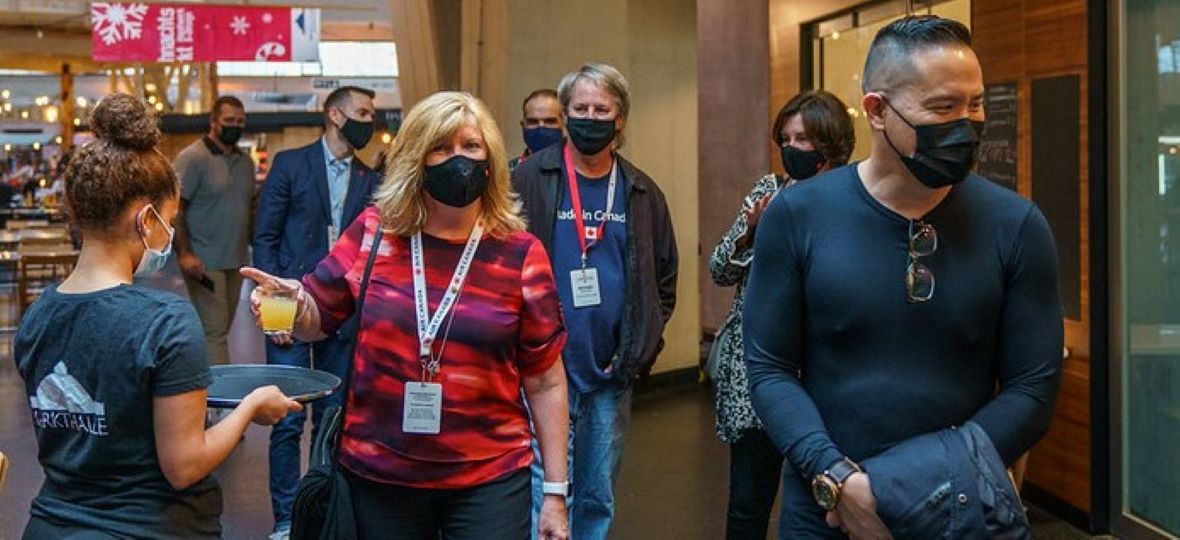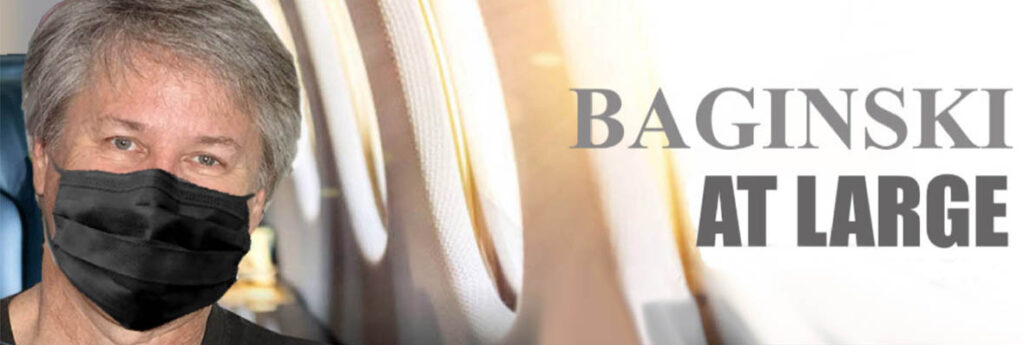The Air Canada captain said he was “pleased” to be flying with passengers again. And the passengers, me included, were certainly happy to comply, though with the new stress of pandemic-era travel, getting there is not quite half the fun. So, here is my view from the ground, and the air, on my first trip since COVID changed the world.
Let me first say that travel now has a “wild west” feel amid a complex and constantly changing series of tests, vaccination forms, and other protocols that vary from destination to destination and airline to airline. As such, please note that the observations here are mainly limited to my home country (Canada), airline provider (Air Canada), and destination (Switzerland).
My travels took place Aug. 27 to Sept. 02 as part of the Air Canada Race 2021, a fabulous event that also welcomed over three dozen travel agents, plus media and trip host personnel. And it should also be noted, in the words of lead Air Canada Race organizer Edna Ray, that Switzerland was perfectly suited for the FAM because it is “a great destination where everything works phenomenally.”
Here then is my story:
BEFORE LEAVING HOME
ArriveCan
All Canadians (and all travellers) travelling internationally are required to have the ArriveCAN app, which can be uploaded at any time before arrival back in Canada (a primary traveller can register family members including children). It is fairly straightforward and takes about 10 minutes to load and fill out – but importantly, cannot be completed until within 72 hours of returning, meaning it must be done in destination, not in advance.
• The app worked on my phone, but not on my older iPad (lap- or desktops are reportedly fine).
• Internet/Wifi connections are obviously necessary to complete the form and proficiency with uploading/downloading, etc., is helpful.
• Proof of vaccination (both doses!) must be uploaded into the app to avoid quarantine; proof of molecular COVID test DOES NOT. The former, apparently needs only to be uploaded the first time, though the government warns that the latest version of the app should always be used.
• Instructions for using the app can be found online and several helpful YouTube videos exist to give walkthroughs
• Tip: Download, screenshot or take photos of both vaccination dose confirmations on your device in advance, but also carry several printed copies of each.
Destination planning
Switzerland does not require a pre-arrival COVID-19 test for fully vaccinated Canadians. However, two pre-arrival forms, one for contact tracing, needed to be completed in advance. It is imperative to check individual arrival protocols for countries being visited (including transit).
Insurance
Some destinations require that travellers possess some form of COVID coverage before allowing entry. Even if they don’t – it’s a good idea. My research into coverage options (I checked Manulife and Allianz) revealed that regular travel insurance generally would cover catching COVID in destination if hospitalization is required (i.e. medical emergency), but NOT costs of quarantine if one tests positive and is simply unable or not allowed to travel. Supplementary coverage must be purchased for the latter. In my case, the supplementary COVID policy amounted to about $5/day for $150/day coverage up to $2,100 total. Neither regular nor supplement insurance covers COVID test costs.
Masks
Air Canada currently accepts cloth masks (but word is that may soon change) for boarding and during the flight, but many airlines now require medical (non-valve) masks. It is imperative that travellers check specific airline requirements in advance.
• Air Canada handed out extra disposable masks in flight (along with the headsets).
• Observation: Chatty neighbours are now largely a thing of the past.
EN ROUTE
Airport
We departed from YYZ, which was busy for an overnight flight. Physical check-in (recommended, even if done in advance online and/or travelling only with carry-on) was slower than previous as agents are required to scrutinize relevant documents (such as vaccination certificates). Customs configurations at Pearson have also changed requiring extra time.
• Tip: Arrive earlier than usual (the airline’s three-hour suggestion is suitable).
Outbound
Easy-peasy. The flight was medium full with plenty of open middle seats (not required) and a few open rows in the back of the bus.
Onboard
Masks are required throughout the flight except while eating or drinking; seats cannot be changed due to contact tracing protocols.
Arrival
This was Switzerland: arrival was organized and quick. Customs agents verified the required entry forms, which I had chosen to print, but also had the email verification as back-up.

IN DESTINATION
In Switzerland, masks are required in any indoor setting (except while eating and drinking). Everyone seems to comply without complaint (as it should be). In outdoor settings, most people take their mask off.
The dreaded COVID test
Canadians, including fully vaccinated, must complete a molecular (PCR) test within 72 hours of one’s flight departure time. Ensuring that one has an appointment in place that can provide the test is a critical requirement in planning one’s itinerary. You will be denied boarding without proof of a negative test. Antigen tests are not valid.
• Air Canada: Being hosted by the airline, we lucked out as the trialists in a program that will be rolled out by AC in the coming weeks: In partnership with Switch Health, passengers will be able to purchase a COVID test kit that can be self-administered, thereby eliminating the need to find a local lab in destination. Various levels (and corresponding prices) of the kit will be available, with the “diamond” version including a live video appointment with a Canadian nurse to oversee the test procedure. Results from this version are available in about 30 minutes. (Sounds incredible, and it is!) An antigen test kit (for US flights) will also be introduced for sale (reportedly in multiple units priced at about $30/test I’m told).
• Test results: Once a negative test result is received, whatever the source, a copy must be downloaded to be shown upon arrival in Canada and uploaded to Air Canada during the check-in procedure. (I did so through the airline’s app, others on a laptop; again, technical proficiency is helpful).
• Tip: Registering for Air Canada’s Canada-based test required producing a Canadian health card number, something some travellers may not have. If not carrying the card, take a photo of it for reference. Also, be sure the test is taken strictly within the 72-time window, not before.
• Complaint: Notwithstanding the exorbitant cost of an incredibly inconvenient test 72 hours before travelling, that still leaves three days for the traveller to encounter someone with COVID. A better solution, in my opinion, would be a pre- check-in antigen test. While the latter is deemed not as accurate as a PCR test, it would surely outweigh having an unaccounted-for 72-window between test and flight.
HOMEWARD BOUND
Zurich airport (where everything works “phenomenally”) was extremely busy on the afternoon of our departure, though exceedingly calm at the Air Canada check-in. Except for everyone wearing masks, you’d never know this was the middle of a pandemic. From check-in to gate was only 30 minutes.
• Check-in: Beyond usual boarding procedures, we were required to show email proof of approval from Air Canada after checking in online (with proof of negative COVID test uploaded into the app); proof of vaccination (a copy of EACH dose; it should be noted for outbound travel that mixed doses may not qualify for entry into a country), and a verification code sent via email by ArriveCAN after the online form was completed.
• Tip: That’s four proofs required throughout the travel process:
• ArriveCAN code (including two vaccination certifications)
• vax certifications (electronic and printed copies of both doses)
• negative COVID-19 test result taken within 72 hours of travel to Canada
• Air Canada approval (sent via email) of health documents after online check-in.
BOARDING
Here’s where the fun really starts. Having checked in at the terminal and shown all the aforementioned documentation, I received (unbeknownst to me, until later) a red sticker on the back of my passport and special stamp on my boarding card. These important markers indicated that my docs were approved and I was good to go when called to board. In-transit passengers, without those markers, however, were required to visit a kiosk beside the gate (lengthy line) for verification. This notable safety measure resulted in several passengers (without the proper documents) being denied boarding and a slight departure delay as their luggage was off-loaded.
• Tip: Airport bar hounds might note that general boarding started about an hour before departure to accommodate the more involved protocols.
ONBOARD
The flight home was similar to the flight away, with the exception that this one was packed – in this case with passengers from India connecting through Qatar, suggesting an alternate route for travellers while Canada continues to bar flights from the country.
• Observation: Perhaps more people are trying to get into Canada than to leave it at the moment.
• Air Canada takes its mask policy seriously. Though I witnessed no dissent, passengers were warned mid-flight that failure to observe the mandate would lead to arrest upon arrival.
• Tip: Don’t doddle getting to the gate if your docs have not been checked; overhead bin space is also at a premium (some pax had carry-on bags taken away as checked luggage).
HOME SWEET HOME
Tales of deplaning and customs chaos are becoming legend – passengers stuck on planes for hours awaiting clearance, then hours queued in customs. On the other hand, a friend arriving from Iceland recently was out of Pearson in only 45 minutes after landing. In our case, we were warned of a customs logjam that would delay our exit from the plane; sitting in Row 22 (mid-plane), I waited about 45 minutes to exit, the time mitigated a little by orderly row-by-row disembarkation ahead of me (preceded by plane-wide passengers with connections).
Customs was also quicker than advertised: with my Nexus, I marched straight through with ease, while the non-Nexus maze appeared no worse than usual. The only difference was having to show my vaccination statements (both) and negative COVID test to a customs agent, who did not ask for my ArriveCAN code (though presumably it was “in the system.”)
• Lastly: Arrivals exiting the customs hall after picking up luggage are subject to be selected for random testing. A quick check of the back of my passport (for the red sticker, I assume), saw me through with a smile.
WAS IT WORTH IT?
Yes – it was good to be on the road again, and, like a long plane ride, the new annoying protocols were quickly forgotten. Plus, travel restrictions and protocols will undoubtedly continue to evolve and become more efficient, easing the travel stress further. After all, 18 months ago, we couldn’t travel at all.
In the longer term, due to 9/11 and its aftermath, we have become accustomed to travelling without liquids, eating with plastic utensils, sending shoes through the x-ray machine, and wearing clean underwear in case our pants fall down when we remove our belts. We adapt.
At the same time, fingers crossed, this too shall pass.

